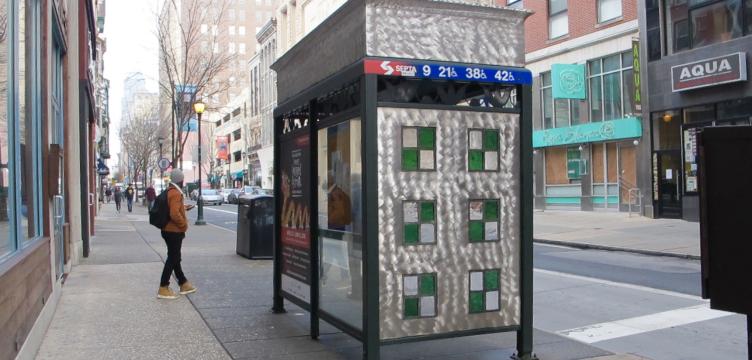Artist Speaks Out On City Proposal To Scrap His Work

At January’s Art Commission meeting, the city attempted to deaccession the eleven stained-glass decorated bus shelters that line Chestnut Street in Center City.
The proposition stirred up a storm of opposition and the city eventually withdrew the idea, for now anyway. At the time, PlanPhilly reported that Pablo Tauler, the artist who created the uncommonly attractive bus shelters in 1999, seemed to be the only one who wasn’t vociferously opposed to the deaccessioning.
“I talked to Pablo and he was completely understanding and not upset by it,” said Margot Berg, Philadelphia’s Public Art Director, during her presentation to the commission. “He understands that these kinds of things happen in the urban environment.”
Tauler, however, is upset by it.
“I was absolutely floored,” said Tauler, who found PlanPhilly’s article by chance. “When I spoke with the city last year, they made it sound like it would just be a few of them, maybe they would be relocated. They made it sound like it was a done deal.”
The artist said that he’d been unaware that there could be an alternative to the removal of the colorful shelters. In short, he wasn’t aware of the power the Art Commission would wield over his work’s fate.
All artists’ contracts with City of Philadelphia give the municipality the right to relocate or remove the artwork if necessary. In this case, serious repair work is needed on the basic aspects of the shelters that Tauler did not work on. (They also lack seating.) The city deemed it prudent to scrap these 11 shelters, along with the hundreds of others in the portfolio, and replace them with new structures that feature both benches and digital advertising. Citywide the new signage is projected to net over $100 million in the next 20 years.
It is the Art Commission’s duty to approve—or not–of commissions, deaccessions, relocations, and conservation work. Chairman Greenberger says, however, that while they can veto the removal of the art they probably can’t force the city to keep the Chestnut Street shelters.
The question before them at the January meeting was deaccession and if they’d veto it the city would still have options. They could leave the art there until it decayed beyond safe use, repair or replace the shelters with the art in place, or come up with a new proposal for the commission’s consideration. But that choice wouldn’t be up to the commission, only the removal of the art.
Tauler says he wasn’t made aware that there was a veto point at all on that question. He also wasn’t aware the Art Commission had a say over his work’s fate or that there would be a public meeting where a case for it could be made.
“It was so strange,” says Tauler, “I wasn’t approached by anyone, not even the art commission. If I had been I would have shown up.”
As for Berg, she says that the city’s plans were all made clear to Tauler. In any case, the city is still unclear what it will decide to do moving forward now that the commission’s opposition is clear. “This matter is still being investigated, understanding the concern expressed by the public over the fate of the artwork,” says Berg in an email message.
The next Art Commission meeting Wednesday, February 1. The question of the stained-glass Chestnut Street bus shelters is not on the agenda.
WHYY is your source for fact-based, in-depth journalism and information. As a nonprofit organization, we rely on financial support from readers like you. Please give today.




